COLLIT - PROJECT
INDORE
Information Communication Technologies have really increased the pace of development today and this is strongly believed by the workers of different sectors. This is true not only for India but for the world over. India has also taken many steps to popularize ICT, as an important tool to support the functioning of it's various sectors. This includes its different departments and the cells. Private sectors had some how never said no to the technology! It took them comparatively lesser time to adapt the new technology based working systems. In last two decades things have really changed.
There have been small initiatives in the use of ICTs in the rural areas in different sectors such as education, micro credit, health and nutrition. There are examples like Sustainable Access in Rural India (SARI) in Madurai, Community Information Centres (Gyandoot) in Dhar, Dewas, Ujjain and Mandsaur (MP), Tarahaat in MP. There are other examples involving women for literacy through use of ICTs like the Commonwealth of Learning project in three states of India; Women into e-commerce in Bangladesh with the Village Phone entrepreneurship development through the support of Grameen Bank.
Use of ICT for Education Technology has been playing a vital role in the area of education. Distance Education centres and Universities to network institutions across the country, such that they share their resources, are using ICTs. It enables the best university, professors and curriculum available to all students, without regard to geography, distance, resources, or caste.
The Project
When this was all happening, there was also an experiment going on in two of the Hindi speaking states of the country. This was the COLLIT Project. The project was being experimented in two countries i.e. India and Zambia. In India three organizations were chosen as partners viz. -
- State Resource Center, Indore, Madhya Pradesh
- State Resource Center, Jaipur, Rajasthan
- MSSRF, Research foundation, Chennai
COLLIT Project –
The Commonwealth of Learning Literacy Project which focused on the use of ICTs for literacy has recently completed its project cycle. The project took off in 1999 in partnership with the State Resource Centres of Rajasthan and Madhya Pradesh and the M.S.Swaminathan Research Foundation in Tamil Nadu. The literacy workers were also selected from among the communities from where the project had the adult learners. The series of multi-media and audio-visual trainings were imparted to the learners and the instructors. The illiterate adults became computer literates within a year's time. The learners have developed their own learning materials with the application of digital technology by incorporating the items and articles of daily use. The families decide what the learner from their family would learn and they monitor their learning milestones through their monthly meetings. The other issues of water harvesting, women's health, adolescent health and awareness programs, use of bio-manure, bio-pesticides and hybrid seed cultivation also formed part of their holistic development. The needs of all the age groups were addressed which fell under the purview of the community learning centres. The community learning centres are set up in the villages, the land and the building provided by the communities. The community and the women own the technological equipments and share the responsibility of the centre.
The organizations were selected as partner agencies for this pilot project. As the focus of project was on 'promotion of technology based literacy', the organizations selected were those that had some background of working with ' Literacy', thus the SRCs. MSSRF was chosen as it had an intensive experience of working with the rural communities with agriculture and science. Thus, the agencies selected had a varied background and context, but three partners had one commonality i.e. all were NGOs.
The project officially began in September '99. And was in operation till March 2003. it was in this working span that the projects went thru many experiences and these experiences had been the learning lessons for each of the organization.
The concept of a community-based learning centre, where various types of ICT equipment could be deployed, managed and accessed by members of the community, where learning could be facilitated and where locally relevant learning materials could be developed, was a central ingredient in the COLLIT project. Not surprisingly, and due to the different approaches taken towards literacy development, the process of developing the centres in the two countries, and the form that resulted, differed. Interestingly, however, the differences were even greater among the intra-country venues, reflecting not only different community cultures, but also marked differences among the local implementing partners in terms of their approach to literacy programming and the way they developed partnerships with learners, neighbouring communities and other community organisations.
Here we shall talk about the Indore based project in detail so that an overall picture emerges for clearer and better understanding.
SET UP of CENTREs
SRC Indore set up one centre in Rau, close to Indore city and another in Jamli, 30 kilometers from Indore. The centre at Rau was housed in a building of an NGO and the one in Jamli, as in Jhir, was in a rented private house.
Rau is a small, semi-urban town with a population of about 21,000, mostly migrants from the rural areas of Madhya Pradesh. It has access to several services and facilities, such as a post office, a nationalised bank, a co-operative bank, a government hospital, four private dispensaries and several public and private educational institutions. Almost all houses in Rau have electricity. Most of the people are landless and work as agricultural wage laourers in the surrounding farms. Some also work as construction labourers.
Jamli is a medium-size village of 630 households with a population of 5500. It is well linked to surrounding villages by road. This multi-caste community consists of the socio-economically dominant community of Patidars and the disadvantaged communities of the scheduled castes and scheduled tribes. The literacy rate for Jamli is very low and the agrarian economy of the village is differentiated by class and caste with the scheduled castes and tribes being mostly landless agricultural labourers. About 79 per cent of the households have electricity, but the power supply is irregular. Nearly 50 per cent in the village have televisions, but there are only 50 radio sets available.
Process
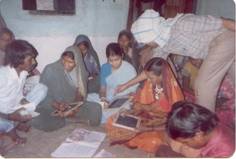 The project went thru many phases before the actual start off. This included the Visualization of the project, Mobilization of the community, planning for the project, Setting the structure and getting the centers set-up and also designing the curriculum.
The project went thru many phases before the actual start off. This included the Visualization of the project, Mobilization of the community, planning for the project, Setting the structure and getting the centers set-up and also designing the curriculum.
The project was initiated nearly six months prior to the actual start off date. This was done in the form of selecting the community sites where the project was to start? This included intensive meetings with the community not only one or two but also a series of meetings were arranged. These meetings with the community focused on exploring the interest of the community in ICT and also on briefing them on what the project was about and generating need. It was in these meetings that the community was also urged to identify some volunteers for taking up the responsibility of project. This process continued till the sites were finalized and the workers were identified. There after the project was set operational from September 1999. i.e. when the machines and other equipments were received.
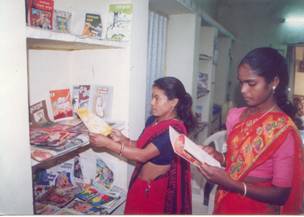 Each of the centers was characterized with the teaching -learning activity and a small library. Two types of curriculums were designed one was the regular literacy package and the other was technology based curriculum. There after the task of identifying the learner was taken up which was not easy. There was hesitation among the adult learners to come to the technology centres as they felt that technology was meaningful only for the younger generation. Meanwhile, there was encouraging response from the youth and children. The next task was to form different batches to streamline the teaching learning processes. This was done on the basis of the age group as well as the learning needs indicated by the learners.
Each of the centers was characterized with the teaching -learning activity and a small library. Two types of curriculums were designed one was the regular literacy package and the other was technology based curriculum. There after the task of identifying the learner was taken up which was not easy. There was hesitation among the adult learners to come to the technology centres as they felt that technology was meaningful only for the younger generation. Meanwhile, there was encouraging response from the youth and children. The next task was to form different batches to streamline the teaching learning processes. This was done on the basis of the age group as well as the learning needs indicated by the learners.
Inputs
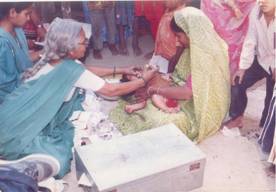 A large number of inputs went into the project and there was a wide range of events happening all around. While teaching learning and library remained a regular activity at the centres there were many more academic and informative centres sessions arranged at each of the centre to support the learning and information sharing. The sessions taken up were based on the Need Assessment exercises done with the learners. There were sessions on Animal Husbandry, Bio- fertilizers, Educational games, Reproductive Health and AIDs etc. Each of the session included effective use of multiple technology equipment and also supported with the physical and digital materials. The Facilitators initiated these sessions and at times other Resource Persons were also invited. There were also several activities taken up which were not totally academic but were educative and targeted at improving the interpersonal communication skills of the learners. These ranged from debate, to quiz, to extempore and excursion trips etc. On demand from the learners there were also tailoring classes arranged for skill development.
A large number of inputs went into the project and there was a wide range of events happening all around. While teaching learning and library remained a regular activity at the centres there were many more academic and informative centres sessions arranged at each of the centre to support the learning and information sharing. The sessions taken up were based on the Need Assessment exercises done with the learners. There were sessions on Animal Husbandry, Bio- fertilizers, Educational games, Reproductive Health and AIDs etc. Each of the session included effective use of multiple technology equipment and also supported with the physical and digital materials. The Facilitators initiated these sessions and at times other Resource Persons were also invited. There were also several activities taken up which were not totally academic but were educative and targeted at improving the interpersonal communication skills of the learners. These ranged from debate, to quiz, to extempore and excursion trips etc. On demand from the learners there were also tailoring classes arranged for skill development.
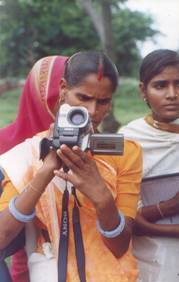
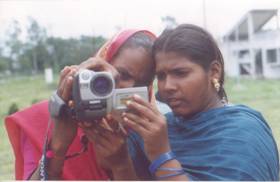 In order to upgrade the skills of the workers at different levels some training programs were also organized like that of: Computer training, training on preparation of Instructional design, training program on Multi Media, training on use of Audio-Visual equipments etc. these were not organized just at one level but were replicated at different levels. Besides, there were some special workshops organized to promote and strengthen the reading writing skills of learners like the creative writing workshop.
In order to upgrade the skills of the workers at different levels some training programs were also organized like that of: Computer training, training on preparation of Instructional design, training program on Multi Media, training on use of Audio-Visual equipments etc. these were not organized just at one level but were replicated at different levels. Besides, there were some special workshops organized to promote and strengthen the reading writing skills of learners like the creative writing workshop.
As part of academic and technical support there was a regular field contact system, which was supported by the regular meetings. These meetings were held at all the levels and proved to be very fruitful. A separate committee was formed at the local levels for supporting the project and it worked effectively.
Many educational CDs were provided at the centres to support the teaching learning processes. Some of these were purchased while some were prepared as part of the project. Besides there were projects prepared by the project functionaries on different issues, which ranged from Power Point to Multi Media. These were frequently used at the centres and earned high appreciation of the learners.
Interventions
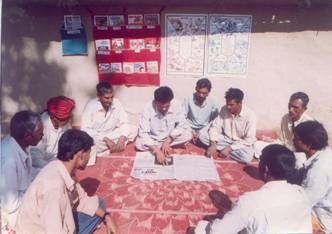 There were several other interventions that went into the project and one such important intervention was the levels of Evaluations that were taken up in the project. Apart from in-house monitoring there were In country Evaluations, International Evaluations and also the Final Evaluation from IRMA. There were many international visitors, and their contributions to the project were very useful. This was not only in terms motivating the project personnel but also in terms of their feedback and guidance. In fact these visits were very helpful for developing a vision for the project.
There were several other interventions that went into the project and one such important intervention was the levels of Evaluations that were taken up in the project. Apart from in-house monitoring there were In country Evaluations, International Evaluations and also the Final Evaluation from IRMA. There were many international visitors, and their contributions to the project were very useful. This was not only in terms motivating the project personnel but also in terms of their feedback and guidance. In fact these visits were very helpful for developing a vision for the project.
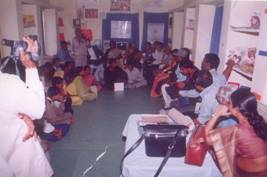 Outcomes and Impacts
Outcomes and Impacts
The project not only helped the functionaries from top to bottom to built up and develop the technology related skills and optimize its use in the everyday work. Besides, as this was the firsthand experience of the organization of working with Technology and Literacy, it gained a lot of experience. In fact it was a good learning opportunity for the organization too.
There were too many things happening in the project and it is a challenging task to pen every thing down. Still there are many instances documented at the project and the evaluation agency level. The major impacts that have shown up are in terms of:
- Level of Mobilization at the local levels
- Skill enhancement that happened at almost all the levels
- CLCs becoming the focal point of convergence at community and organizational level
- Attitudinal Changes in the learners
- Development and promotion of reading culture at community level
- A large amount of materials were generated by the learners, which were in different forms like the wall newspaper, folder, Chart, Posters and stories etc. These were supported with the technology also.
Impacts
The following observations were made by the country evaluator for India following discussions with learners on their impact of literacy in their lives:
No matter how rudimentary the literacy skills acquired by the learners were, most of them reported that they had started using them. The most frequently cited examples were reading bus schedules and station signs, banners, posters and advertisements. A few women also mentioned that they now read printed labels and prices on the products at the local grocery shop. Some reported reading the captions and titles of television serials. Learners who were involved in agriculture started reading agriculture commodity prices at the centre and in the market. Several learners reported reading materials such as newspapers and books from the centre libraries. Those with school going children also read children's textbooks. Clearly, reading various types of material opened the learners to the world of print.
In general, learners used writing skills less than reading skills, perhaps because of limited opportunities to write in their immediate environment. However, although they used writing skills less frequently, being able to sign their name and do small writing tasks did enhance the learners' self-esteem. Most of the writing applications were limited to specific purposes such as signing various forms and applications such as ration cards, attendance registers, children's report cards, bank/post office forms, government scheme forms, etc. A few women used writing skills for preparing shopping lists. Those who were engaged in small trades and other income-generating activities used writing skills for maintaining business accounts and client lists.
Most of the learners reported using numeracy skills, most frequently for counting and handling money in transactions, maintaining household accounts, reading bus numbers, and telling time. Learners who were engaged in wage labour used numeracy skills for monitoring wage payments, saying that now nobody could cheat them! A few learners used their newly acquired skills in business activities, such as keeping business accounts, taking measurements of tiles and bricks for masonry work, using a measuring tape, taking measurements for tailoring, etc. Women learners also felt that numeracy skills had increased their ability to check prices, buy/sell products and figure out correct payments.
Parents reported a new ability to read the report cards of their school-going children and monitor their educational progress. Some parents also started interacting with the school teachers and developed better awareness about the progress of their children's education.
For the school dropouts who joined literacy classes, the learning centres provided the second chance for education. Literacy classes served as an open learning situation for acquiring basic literacy skills and accessing new knowledge and information. After acquiring some fluency in literacy, these young learners aspired to pursue further studies either at the centre or in formal schools.
The acquisition of literacy skills was greater for learners who could link the skills being taught with livelihood activities, such as small trades, animal husbandry, agriculture, wage labour and non-farm occupations. Small increase in savings or increased income as a result of their improved abilities were perceived as the most empowering experience by the learners. Some of the wage labourers from Rau and Pudupatty also found literacy skills useful in finding better opportunities for work outside the village. Earlier they worked as wage labourers in the village or surrounding villages, but once they could read the bus board, their mobility increased and they started travelling to distant places to find better opportunities for work.
Acquisition of literacy skills also enabled learners to use the telephone for social communication and business activities, which, some reported, had considerable economic benefits.
The learning centres also introduced the learners to new functional knowledge either through literacy material or through specific continuing education activities. Learners started reading books from the centre library on divergent topics. For example women at the SRC Indore centres reported that they learned about balanced diets and the nutritional value of different foods, proper hygienic practices, how to make a first aid box, the importance of sterilized needles, sanitation and water conservation. For those involved in agriculture, access to information on agricultural prices and how to grow specialised crops was felt to be very useful. A few male learners from the MSSRF centres also mentioned that they had a new awareness about gender-based division of work.
The facilitators using the computer, printer and scanner developed several instructional aids such as word and memory games, as well as cards showing alphabets, name of flowers, fruits and colours.
As the staff received trainings, they were able to use powerpoint and visual basic to create multimedia materials on reading and writing skills as well as on legal rights, health and water conservation.
The project staff also downloaded material from Internet on specific themes and issues of current relevance to the communities. Printouts of downloaded material were placed at both the centres where the facilitators used them in reading and writing sessions.
The process of material generation promoted teamwork and provided learners with an opportunity to express their ideas. Further, it instilled the sense of pride and accomplishment in the learners when they shared what they had produced with other learners at other centres.
A set of 5 CDs as part of soft material for the centre was produced by the organisation was largely used not only by the regular learners but by the community as a whole.
Those who were classified as "computer learners" tended to be younger than the "literacy learners" and were either in school or had some schooling and therefore were able to read. They were motivated by acquiring computer skills that would help them get jobs or pursue further education. While a few did realise these goals, for most the results were different. Most of them reported that they used the centre's library for reading books and newspapers. They participated in many of the activities at the centres which provided them opportunities to develop their communication skills and enhance their self-esteem. They also interacted with literacy learners, which sensitized them to work together with illiterate and semi-literate people; it became a common sight in all the centres to observe computer learners assisting literacy learners to use the computer and with other learning tasks. The computer learners at Jamli centre came from higher castes and they reported that these experiences provided them the opportunity to overcome caste and class barriers and assist learners from the socio-economically disadvantaged sections of society. Indeed, some of the computer learners from Jamli centre became volunteers who assisted the facilitators in running the centres. They also helped the facilitators in organising various community based activities. As they became well versed with centre operations and management, they often ran the centre in the absence of facilitators.
Challenges
In spite of all the impacts that occurred there were many challenges that the project had faced and it will be worth sharing it. Although visualized at the project level that Net connectivity will be available at the learning centers, it could not happen, as the center sites were not accessible thru net. Then there was too frequent equipment breakdown and it took quiet some time to get it attended! Thus, the learning pace slowed down at the centers. The initial hitch of the community towards technology was a big challenge to get the adult learners at the centre. Although electrified there was regular and long Load shedding in the project areas, thus rendering the equipments defunct. The Indore district had faced draught for almost three years, as a result of which there was migration of the actual learners for search of bread and butter. Due to constant irregularity of the adult learners and their life related issues the learning pace was also low. Thus with all this challenges it was indeed difficult to survive but still it happened! Which one can say is commendable.
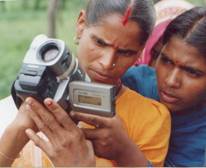 |
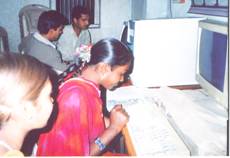 |
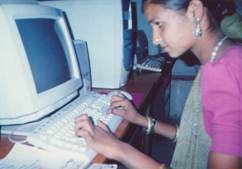 |
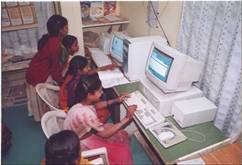 |
